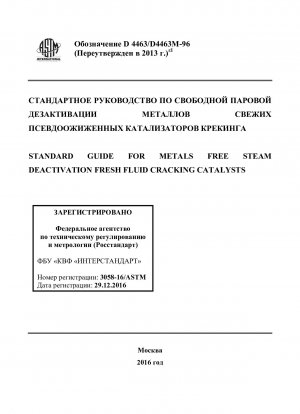ASTM D4463/D4463M-96(2013)e1
Standard Guide for Metals Free Steam Deactivation of Fresh Fluid Cracking Catalysts
- Standard No.
- ASTM D4463/D4463M-96(2013)e1
- Release Date
- 1996
- Published By
- American Society for Testing and Materials (ASTM)
- Status
- Replace By
- ASTM D4463/D4463M-19
- Latest
- ASTM D4463/D4463M-19
- Scope
4.1 In general, steam treatment of FCC catalyst can be used either to compare a series of cracking catalysts at a simulated equilibrium condition or conditions, or to simulate the equilibrium condition of a specific cracking unit and a specific catalyst. This guide gives an example for the first purpose and an approach for the latter purpose.
1.1 This guide covers the deactivation of fresh fluid catalytic cracking (FCC) catalyst by hydrothermal treatment prior to the determination of the catalytic cracking activity in the microactivity test (MAT).
1.2 The hydrothermal treatment of fresh FCC catalyst, prior to the MAT, is important because the catalytic activity of the catalyst in its fresh state is an inadequate measure of its true commercial performance. During operation in a commercial cracking unit, the catalyst is deactivated by thermal, hydrothermal and chemical degradation. Therefore, to maintain catalytic activity, fresh catalyst is added (semi) continuously to the cracking unit, to replace catalyst lost through the stack or by withdrawal, or both. Under steady state conditions, the catalyst inventory of the unit is called equilibrium catalyst. This catalyst has an activity level substantially below that of fresh catalyst. Therefore, artificially deactivating a fresh catalyst prior to determination of its cracking activity should provide more meaningful catalyst performance data.
1.3 Due to the large variations in properties among fresh FCC catalyst types as well as between commercial cracking unit designs or operating conditions, or both, no single set of steam deactivation conditions is adequate to artificially simulate the equilibrium catalyst for all purposes.
1.3.1 In addition, there are many other factors that will influence the properties and performance of the equilibrium catalyst. These include, but are not limited to: deposition of heavy metals such as Ni, V, Cu; deposition of light metals such as Na; contamination from attrited refractory linings of vessel walls. Furthermore, commercially derived equilibrium catalyst represents a distribution of catalysts of different ages (from fresh to gt;300 days). Despite these apparent problems, it is possible to obtain reasonably close agreement between the performances of steam deactivated and equilibrium catalysts. It is also recognized that it is possible to steam deactivate a catalyst so that its properties and performance poorly represent the equilibrium. It is therefore recommended that when assessing the performance of different catalyst types, a common steaming condition be used. Catalyst deactivation by metals deposition is not addressed in this guide, but is addressed in Guide D7206/D7206M.
1.4 This guide offers two approaches to steam deactivate fresh catalysts. The first part provides specific sets of conditions (time, temperature and steam pressure) that can be used as general pre-treatments prior to comparison of fresh FCC catalyst MAT activities (Test Method D3907) or activities plus selectivities (Test Method D5154).
1.4.1 The second part provides guidance on how ......
ASTM D4463/D4463M-96(2013)e1 Referenced Document
- ASTM D3663 Standard Test Method for Surface Area of Catalysts and Catalyst Carriers*, 1999-04-20 Update
- ASTM D3907 Standard Method for Testing Fluid Catalytic Cracking (FCC) Catalysts by Microactivity Test (Withdrawn 2001)*, 2021-02-18 Update
- ASTM D3942 Standard Test Method for Determination of the Unit Cell Dimension of a Faujasite-Type Zeolite*, 1997-04-20 Update
- ASTM D4365 Standard Test Method for Determining Micropore Volume and Zeolite Area of a Catalyst
- ASTM D5154 Standard Test Method for Determining the Activity and Selectivity of Fluid Catalytic Cracking (FCC) Catalysts by Microactivity Test
- ASTM E105 Standard Practice for Probability Sampling Of Materials*, 2024-04-20 Update
- ASTM E177 Standard Practice for Use of the Terms Precision and Bias in ASTM Test Methods
- ASTM E456 Standard Terminology for Relating to Quality and Statistics
- ASTM E691 Standard Practice for Conducting an Interlaboratory Study to Determine the Precision of a Test Method*, 1999-04-20 Update
ASTM D4463/D4463M-96(2013)e1 history
- 2019 ASTM D4463/D4463M-19 Standard Guide for Metals Free Steam Deactivation of Fresh Fluid Cracking Catalysts
- 1996 ASTM D4463/D4463M-96(2013)e1 Standard Guide for Metals Free Steam Deactivation of Fresh Fluid Cracking Catalysts
- 1996 ASTM D4463/D4463M-96(2012)e1 Standard Guide for Metals Free Steam Deactivation of Fresh Fluid Cracking Catalysts
- 1996 ASTM D4463-96(2006) Standard Guide for Metals Free Steam Deactivation of Fresh Fluid Cracking Catalysts
- 1996 ASTM D4463-96(2001) Standard Guide for Metals Free Steam Deactivation of Fresh Fluid Cracking Catalysts
- 1996 ASTM D4463-96 Standard Guide for Metals Free Steam Deactivation of Fresh Fluid Cracking Catalysts

Copyright ©2024 All Rights Reserved